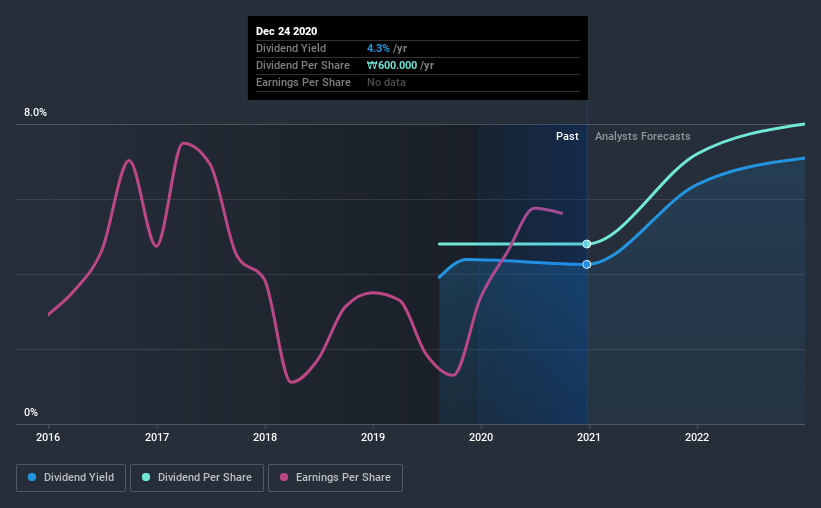- South Korea
- /
- Paper and Forestry Products
- /
- KOSE:A213500
Hansol Paper Co., Ltd. (KRX:213500) Looks Like A Good Stock, And It's Going Ex-Dividend Soon
Some investors rely on dividends for growing their wealth, and if you're one of those dividend sleuths, you might be intrigued to know that Hansol Paper Co., Ltd. (KRX:213500) is about to go ex-dividend in just 3 days. You can purchase shares before the 29th of December in order to receive the dividend, which the company will pay on the 21st of April.
Hansol Paper's next dividend payment will be ₩500 per share, on the back of last year when the company paid a total of ₩600 to shareholders. Based on the last year's worth of payments, Hansol Paper has a trailing yield of 4.3% on the current stock price of ₩14100. Dividends are an important source of income to many shareholders, but the health of the business is crucial to maintaining those dividends. As a result, readers should always check whether Hansol Paper has been able to grow its dividends, or if the dividend might be cut.
Check out our latest analysis for Hansol Paper
If a company pays out more in dividends than it earned, then the dividend might become unsustainable - hardly an ideal situation. Fortunately Hansol Paper's payout ratio is modest, at just 28% of profit. Yet cash flows are even more important than profits for assessing a dividend, so we need to see if the company generated enough cash to pay its distribution. Luckily it paid out just 21% of its free cash flow last year.
It's encouraging to see that the dividend is covered by both profit and cash flow. This generally suggests the dividend is sustainable, as long as earnings don't drop precipitously.
Click here to see how much of its profit Hansol Paper paid out over the last 12 months.

Have Earnings And Dividends Been Growing?
Businesses with strong growth prospects usually make the best dividend payers, because it's easier to grow dividends when earnings per share are improving. Investors love dividends, so if earnings fall and the dividend is reduced, expect a stock to be sold off heavily at the same time. For this reason, we're glad to see Hansol Paper's earnings per share have risen 14% per annum over the last five years. Earnings per share have been growing rapidly and the company is retaining a majority of its earnings within the business. This will make it easier to fund future growth efforts and we think this is an attractive combination - plus the dividend can always be increased later.
Given that Hansol Paper has only been paying a dividend for a year, there's not much of a past history to draw insight from.
The Bottom Line
From a dividend perspective, should investors buy or avoid Hansol Paper? We love that Hansol Paper is growing earnings per share while simultaneously paying out a low percentage of both its earnings and cash flow. These characteristics suggest the company is reinvesting in growing its business, while the conservative payout ratio also implies a reduced risk of the dividend being cut in the future. There's a lot to like about Hansol Paper, and we would prioritise taking a closer look at it.
With that in mind, a critical part of thorough stock research is being aware of any risks that stock currently faces. For example, Hansol Paper has 2 warning signs (and 1 which can't be ignored) we think you should know about.
We wouldn't recommend just buying the first dividend stock you see, though. Here's a list of interesting dividend stocks with a greater than 2% yield and an upcoming dividend.
If you decide to trade Hansol Paper, use the lowest-cost* platform that is rated #1 Overall by Barron’s, Interactive Brokers. Trade stocks, options, futures, forex, bonds and funds on 135 markets, all from a single integrated account. Promoted
Valuation is complex, but we're here to simplify it.
Discover if Hansol Paper might be undervalued or overvalued with our detailed analysis, featuring fair value estimates, potential risks, dividends, insider trades, and its financial condition.
Access Free AnalysisThis article by Simply Wall St is general in nature. It does not constitute a recommendation to buy or sell any stock, and does not take account of your objectives, or your financial situation. We aim to bring you long-term focused analysis driven by fundamental data. Note that our analysis may not factor in the latest price-sensitive company announcements or qualitative material. Simply Wall St has no position in any stocks mentioned.
*Interactive Brokers Rated Lowest Cost Broker by StockBrokers.com Annual Online Review 2020
Have feedback on this article? Concerned about the content? Get in touch with us directly. Alternatively, email editorial-team (at) simplywallst.com.
About KOSE:A213500
Hansol Paper
Produces, distributes, and sells paper products in South Korea and internationally.
Undervalued with moderate growth potential.
Market Insights
Community Narratives



